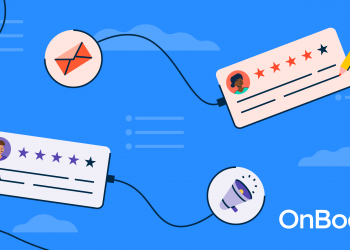How to Start A Podcast: A Complete Step-by-Step Guide (2022) – crowdspring Blog
Many businesses use podcasts to communicate directly with their audience. It’s one of the most effective ways to connect with people anytime and anywhere.
Podcasts allow you to share relevant information, such as updates about your business, industry-related topics, education, and more, with your audience. They also help build credibility, brand awareness, and nurture relationships.
And with over 57% of people from the US listening to podcasts, you should consider whether a podcast makes sense for your small business.
It’s not difficult to start a podcast, but it could be expensive and time-consuming without the proper steps, like good branding and effective promotion strategies.
Here are seven steps on how to start a podcast for your small business:
How to start a podcast:
1. Know your focus and audience
Avoid tackling anything under the sun on your podcast, especially if you’re starting. It’s essential to be specific about the topic of your podcast to attract the right audience. Ask yourself these questions:
- What’s the topic I am interested in most? Do I have a lot of experience or knowledge about that topic?
- Does my target audience resonate with this topic?
- Can I relate this topic to my business?
- How can my brand provide education through this topic? What relevant personal experiences can I share with my audience?
It’s best if your focus is related to your business. This will show your authority and expertise and help raise your credibility and trust with your audience.
After narrowing down your topics, pick an appropriate podcast name that reflects your subject, resonates with your audience, and is brand-appropriate.
Remember that your podcast name will determine your target audience’s interest. So, spend time and develop a list of names that hits all the requirements and narrow it down to the most fitting ones until you finally find the best podcast name for your small business. You can even use a podcast name generator if you’re stuck.
Finally, pick your goals for starting a podcast. Some good reasons to start a podcast are:
- to generate leads
- to build thought leadership and be recognized as an industry leader
- to share important messages
Want a free brand review?
Answer 5 short questions and we will send a custom report with actionable insights and specific actions you can take to build a stronger brand.
We just emailed the info to you.
2. Determine your podcast style
Pick a podcast style and format that suits you best. There are various podcast forms that you can choose from, including:
- Interview
- Solo/monologue
- Panel
- Storytelling
- Conversational/co-hosted
- Theater format
Most podcasts use the interview, conversational, or storytelling format. You can also choose to create a unique format. The important thing is to give your podcast structure to make creating content easier for you and for your audience to digest your content better.
Next, pick the length of your podcast and the frequency of uploads. Most podcasts tend to last 20-45 minutes in length to cover a topic comprehensively. Note that podcasts rarely follow a strict script to appear more genuine and casual to the listeners.
It’s best to upload once a week when you start and adjust your frequency when you better understand your audience. Set and follow a regular schedule for your podcast to ensure consistent, high-quality content for your audience.
3. Choose the right equipment
You don’t need professional equipment for your podcast, especially if you’re starting. Get the right tools that fit your budget and needs. Prioritize getting the most crucial equipment such as:
- Microphones
- Record and editing tools
- A quiet space
The most critical factor in your podcast is the sound. You can start a podcast using an inexpensive headset or your phone’s internal microphone. But that could compromise the listening experience for your audience. Consider investing in a high-quality microphone without breaking your bank.
You will also need audio software to start a podcast. If you own an iPad or a Macbook, you can use the free GarageBand professional-level audio software available on your device. For PC users, you can use Audacity for free.
4. Start recording
Start recording your first podcast. Familiarize yourself with the recording process and record as many times as you want until you’re more comfortable.
Don’t strive for perfection for your first recording. Instead, aim to record to find areas where you think you can improve better. Check if your microphone is working correctly. Learn the basics of audio editing and adding effects to your podcast.
If you’re conducting interviews, make sure you do it properly. Start by building rapport with your guests and making them feel comfortable. Put your conversational skills to use and aim to ask intuitive questions throughout the interview.
Ensure that you ask relevant questions that will provide valuable information for your listeners. Avoid boring your listeners with irrelevant questions.
5. Edit and brand your podcast
Simply sharing your podcasts without cutting irrelevant parts or adding unique elements can quickly bore your listeners. Make sure that the finished product is entertaining and has a brand-appropriate design.
Focus on three vital podcast elements such as:
- Music. Avoid making your audio awkward with blank parts in between conversations or advertisements. Use music to fill in those parts and for your intro and outro. Elevate the rest of your audio recording by adding special sound effects highlighting essential elements of your podcast.
- Voice-overs. Always start your podcast with an introduction about yourself or your business. Start with a short voice-over for introductions and wrap up each episode nicely. This will add a touch of personality to your podcast. You could also include a quick recap about previous episodes on succeeding episodes.
- Art. Make it known who you are. Create brand-appropriate art that includes your brand colors, logo, podcast name, or even the host. You want your listeners to recognize you immediately and boost brand awareness.
6. Upload and promote your podcast
Time to get your podcast live. Choose a platform for your podcast’s official launch. There are many platforms to choose from. Some of the most popular include:
- Apple Podcasts
- Google Podcasts
- Spotify
- Stitcher
- Pandora and more
Pick the platform that best fits you and your technical skills. Some platforms, such as Spotify or Apple Podcasts, might be more familiar to you, making uploading and navigating the platform easier. Ensure to include your podcast platforms on your website for easier access.
Next, promote your podcast before and after your launch. Include your podcast launch in your marketing strategy and get the most out of it by promoting your podcast on all your social channels, blog, and website.
Feedback will naturally come in once your podcast has gone live. Be open to people’s feedback to improve upcoming episodes and increase your listeners.
7. Conduct thorough research
Always aim to be on top of your podcasting game and research the content you put out – even if you have a lot of expertise or knowledge on the matter.
It’s best to be knowledgeable about the topics you’re tackling to avoid misinformation and losing your credibility to your listeners. Make it a goal always to share entertaining, correct, and informative content for your audience.
You can learn from your competitors and see how they conduct their podcasts, how they tackle different subjects, and the ways they engage with their audience. Customize and apply these strategies to your podcast.
Starting a podcast without some support can be lonesome, especially if you have questions. You can join podcast communities such as Podcast Community, She Podcasts, and Podcast Movement to help gain traction and learn more from fellow podcasters.
Advantages of having a podcast
You might still think starting a podcast is troublesome and not worth the effort or resources. Here are ways a podcast can help your small business:
- Podcasts allow you to build a personal connection with your audience. Podcasts showcase your humor, candidness, and how you think and discuss certain matters, making your listeners feel familiar with you. Plus, the informal setting makes you appear more human to your audience.
- Podcasts help you reach new audiences. Podcasts increase your chances of being discovered as a business by new audiences through shares, which helps increase your social proof. People will love you if you keep putting out quality content.
- Podcasts help you repurpose content. You can easily repurpose existing content and tackle it comprehensively to educate your audience better. For example, blog posts can often be limiting because of their word count. But, you can repurpose them for your podcast and discuss them in more detail.
- Podcasts provide additional income. Podcasts can help you earn through sponsorships, ads, and even paid guests. And the more your podcast has increased in reach, the more you can make through it. It’s a great side hustle for your business that helps educate people while entertaining them.
- Podcasts can boost website traffic. Your listeners will naturally get curious about your business, leading them to click on your website and increasing traffic. Ensure that you include your website on your podcast bios if you’re using streaming platforms for your podcast.
Starting something new will always be scary. But if it helps your business grow and, in turn, helps educate your audience with valuable content, then why not?
We regularly update this how to start a podcast guide. We most recently updated this guide on August 30, 2022.
Interested in other types of businesses or how-to guides? Here are our comprehensive guides:
How to Start a Business: The Complete Step-by-Step Guide to Starting a Business in 2022
How to Write a Business Plan (2022)
How To Create an Effective Marketing Plan for Your Business (2022)
How to Start an LLC in 7 Simple Steps (2022)
Branding: The Definitive Guide for 2022
The Definitive Guide to Successfully Rebranding in 2022
What is Brand Identity? And How to Create a Unique and Memorable One in 2022
The Ultimate Small Business Guide to Brand Equity in 2022
Brand Archetypes and How They Can Help Your Business: The Definitive Guide
The Definitive Small Business Guide to Brand Pillars in 2022
How to Tell a Compelling Brand Story About Your Business [Guide + Examples]
The Complete Guide on How to Name a Business
Brand Strategy 101: How to Create an Effective Branding Strategy [GUIDE]
The Definitive Content Marketing Guide
Social Media Marketing: The Ultimate Small Business Guide for 2022
Local SEO: The Definitive Small Business Guide (2022)
Marketing Funnels: The Definitive Small Business Guide (2022)
Cross-Selling and Upselling: The Ultimate Guide (2022)
How to Start a Small Business Blog
Small Business Guide to Lifecycle Email Marketing: How To Grow Your Business Faster
Direct to Consumer (DTC) Marketing: The Complete Guide, with Strategies, Tactics, and Examples (2022)
Google Ads: The Ultimate Small Business Guide (2022)
The Ultimate Guide to Using Twitter for Business in 2022
YouTube Marketing: The Complete Small Business Guide 2022
Instagram Marketing: The Ultimate Small Business Guide for 2022
How to Use LinkedIn: The Ultimate Small Business Marketing Guide
The Ultimate Small Business Guide to Marketing on TikTok
How to Start A Podcast: A Complete Step-by-Step Guide (2022)
SMS Marketing: The Ultimate Small Business Guide [2022]
Public Relations Guide for Small Business (7 Proven PR Tactics)
How to Start a Consulting Business in 2022: The Complete Step-by-Step Guide
How to Start a Real Estate Business in 2022: Complete Step-by-Step Guide
How to Start a Trucking Business in 2022: The Complete Guide
How to Start a Candle Business: A Step-by-Step Guide With Tips and Insights (2022)
How to Start a Property Management Company
How to Start a Successful Online T-Shirt Business in 2022: The Definitive Guide
How to Start an eCommerce Business: A Step-by-Step Guide To Take Your Business Online (2022)
Nonprofit Branding: Complete Guide to Building a Strong Nonprofit Brand in 2022
How to Start a Cleaning Business in 2022: The Complete Guide
6 Businesses You Can Start For Less Than $1,000
Marketing Psychology: What You Must Know To Supercharge Your Marketing
What is a DBA and How to File One For Your Business
How to Start a Clothing Line or Clothing Brand From Scratch in 2022: The Definitive Guide
How to Start a Brewery Business in 2022: The Complete 9 Step Guide
How to Start a Medical Marijuana Dispensary Business in 2022
How to Start an Etsy Shop: Your Comprehensive, No-Stress Guide to Starting an Etsy Shop in 2022
How to Start a Photography Business in 2022: The Complete Step-by-Step Guide
How to Start a Business in Texas: The Complete Step-by-Step Guide (2022)
The Definitive Guide to Creating a Compelling Visual Brand for Your Restaurant in 2022
Conversion Rate Optimization (CRO) Guide: How to Make Your Website Work Smarter (2022)
Facebook Messenger Chatbot Marketing: The Definitive Guide (2022)
Branding for Food Trucks: The Definitive Guide (2022)
Source by www.crowdspring.com











